If you do
NOT see the Table of Contents frame to the left of this page, then
Click here to open 'USArmyGermany'
frameset |
3rd
Constabulary Brigade
US Constabulary
Looking for more information from military/civilian
personnel assigned to or associated with the U.S. Army
in Germany from 1945 to 1989. If you have any
stories or thoughts on the subject, please contact me . .
|
|
|
|
|
| |
| Brigade
History |
|
| May 1946
- September 1947 |
| (Source: ) |
Headquarters and Headquarters Troop, 3rd Constabulary Brigade, US Constabulary, was organized on 1 May 1946 at Stuttgart, Germany from personnel of Headquarters and Headquarters Company, Combat Command "B", 4th Armored Division.
In the early period, the brigade consisted of a Headquarters and Headquarters Troop located at Stuttgart to which three regiments were attached:
 6th CON Regiment at Bamberg 6th CON Regiment at Bamberg
 10th CON Regiment at Stuttgart-Möhringen 10th CON Regiment at Stuttgart-Möhringen
 14th CON Regiment at Kitzingen 14th CON Regiment at Kitzingen
|
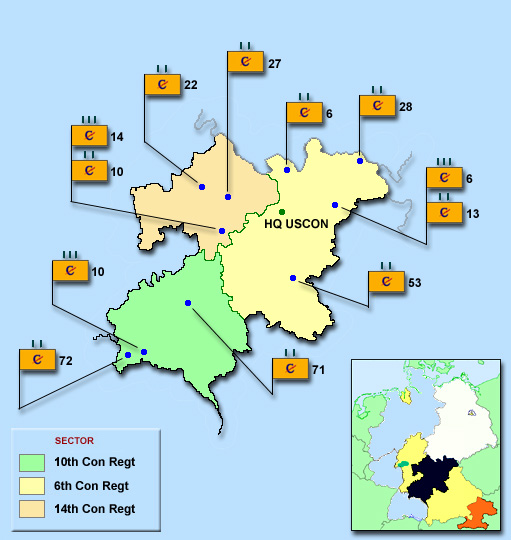
May 1946 -- Area of Responsibility and Disposition of units of the 3rd Constabulary Brigade
|
| |
3rd Brigade was responsible for law enforcement and security within the German administrative districts of the Land Württemberg and the Bavarian Regierungsbezirke of Ober-and Mittelfranken and Mainfranken.
In accordance with a EUCOM directive, the US Constabulary was re-organized under a troop ceiling of 18,000 between July and August, 1947. The mission of the Constabulary remained unchanged. |
| |
If you have more
information on the history or organization of the 3rd Con Bde,
please contact me . . |
|
| |
| ORGANIZATION (May 1946 - September 1947) |
|
6th Constabulary Regiment - Assigned Units |
|
HQ 6th Con Regt |
Bamberg |
originally located in Bayreuth; moved to Bamberg On February 21 after HQ USCON moved to Heidelberg; on August 22, Regimental Headquarters moved to Schweinfurt |
|
6th Con Sqdn |
Coburg |
|
|
13th Con Sqdn |
Bamberg |
joined the 6th Regt (detached from 10th Con Regt) on 23 June 1946; originally located in Bayreuth; then moved to Bamberg (early summer 1947?); inactivated on 20 Sep, 1947 |
| |
28th Con Sqdn |
Hof |
inactivated on 20 Sep, 1947? |
| |
53rd Con Sqdn |
Schwabach |
|
|
10th Constabulary Regiment - Assigned Units |
|
HQ 10th Con Regt |
Stuttgart-Möhringen |
inactivated on 20 Sep, 1947 |
|
71st Con Sqdn |
Hessental (Sch. Hall) |
inactivated in June 1947(?); redesignated as 15th Con Sqdn with station in Schwäbisch Hall |
|
72nd Con Sqdn |
Panzer Ksn, Böblingen |
inactivated in Sep 1947; redesignated as 14th Con Sqdn with station in Böblingen |
|
14th Constabulary Regiment - Assigned Units |
|
HQ 14th Con Regt |
Flak Ksn, Kitzingen |
moved to Fritzlar as part of the reorganization of Sept 1947 |
|
10th Con Sqdn |
Flak Ksn, Kitzingen |
moved to Fritzlar in 1947 where it replaced the inactivated 11th Con Sqdn |
| |
22nd Con Sqdn |
Lager, Hammelburg |
replaced the 91st Con Sqdn in (Bad) Hersfeld in 1947 |
| |
27th Con Sqdn |
Flugplatz, Schweinfurt |
replaced the 14th Con Sqdn in Darmstadt in 1947 |
|
|
 |
|
| |
| 6th Constabulary Regiment |
| |
| (Source: Email from Robert Monasmith, National Adjutant, U.S. Constabulary Association) |
| I would like to add some information regarding early years of the 6th Cavalry Group. I was reassigned to the 6th while it was originally in Coburg. I became a part of HQ of the 6th Squadron. The next morning we moved to Berlin, where we conducted liaison patrols between the outposts along the Russian Zone. At that time the 2nd Armored Division was there, which was soon replaced by the 82nd Airborne. We arrived in Berlin in July 1945, and were reassigned to Erlangen in November 1945. Of course after Erlangen we were reassigned to Coburg as the 6th Constabulary Regiment. I left the outfit just prior to them becoming the 6th Armored Cavalry Regiment. |
|
| |
| (Source: A Year with the Unicorns, Sixth Armored Cavalry Regiment, 1951-52. ) |
| With the coming of peace in Europe, the Sixth Cavalry Group assumed the duties of maintaining road blocks and motor patrols, and guarding various US installations. During the month of February, 1946, the Group was relieved of all commitments and ordered to devote its entire effort toward training for Constabulary duties. In addition, the Group trained cadres for the newly formed Tenth and Fourteenth Constabulary Regiments. |
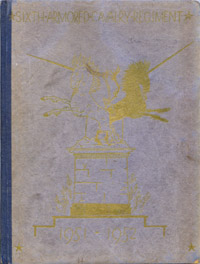 |
|
In a major reorganization, to tailor the unit to the needs of the brand-new United States Constabulary which was designed especially for occupation duty in Germany, the Sixth Cavalry Group (Mecz) was redesignated the Sixth Constabulary Regiment and its attached squadrons were named the 6th and 28th Constabulary Squadrons, respectively. In addition, the 53rd Armored Infantry Battalion, formerly a part of the 4th Armored Division, was assigned to the Regiment and redesignated the 53rd Constabulary Squadron.
The Regiment was under the command of Colonel William T. Hamilton for the entire period and an entirely new chapter in a long and honorable history was begun.
On the 23rd of June the 13th Squadron was attached to the Regiment. This increase in Regimental strength was accomplished in order that the Regiment could properly patrol and safeguard the relatively large stretch of boundary between the United States Zone and the Russian Zone, and between the US Zone and Czechoslovakia, as well as the large interior area of responsibility.
The Sixth Constabulary Regiment became operational on the 1st of July, 1946, relieving elements of the First US Infantry Division. |
|
For the balance of the year, the Regiment engaged in routine duties of patrolling and guard duty, interspersed with occasional practice alerts at potential trouble spots. Police and security methods were perfected and the Regiment developed its ability to carry out its missions. December saw the great majority of tactical troops, other than Constabulary, either inactivated or rendered ineffective by dispersal, and the full tactical burden became the responsibility of the Constabulary.
The first CP was established at Erlangen. Early 1947 found the Regiment dispersed as follows: Regimental Headquarters and Dog Troop of the 13th Squadron at Bayreuth, 6th Squadron at Coburg, 28th at Hof, and the 53rd at Schwabach. An account from the now defunct "Unicorn Free Press", the Regimental newspaper in those days, describe raids for singling out suspect SS Troopers, for apprehension of Germans impersonating American officers, and many incidents in the routine border patrols and check-point maintenance.
On February 21, the Regimental CP moved from Bayreuth to Bamberg, although driving conditions were miserable.
During the summer of 1947, Colonel Hamilton was relieved by Col. Warry J. Wheaton, who assumed command of the Regiment at Bamberg. Later, August 22, Regimental Headquarters moved to Schweinfurt.
Then on the 1st of September, 1948, Headquarters and Service Troop, with Band and Medical detachment, moved to Straubing, Germany. This was a permanent change of station and the units were based on Regensburg Military Post for supply and evacuation. Also, at this same time, 5 September, to be exact, the following units were relieved from their attachments and assigned to the Sixth Regiment:
 25th Constabulary Squadron (now the 1st Battalion) 25th Constabulary Squadron (now the 1st Battalion)
 51st Constabulary Squadron (now the 2nd Battallion) 51st Constabulary Squadron (now the 2nd Battallion)
 53rd Constabulary Squadron (now the 3rd Battalion) 53rd Constabulary Squadron (now the 3rd Battalion)
On 20 December, 1948, the 6th Constabulary Regiment was redesignated the Sixth Armored Cavalry (US Constabulary) and Headquarters and Service Troop became Headquarters and Headquarters Company. At the same time, Service Company was activated. "Troops" became "Companies". and "Squadrons" became "Battalions".
1949 found the Regiment in the middle of reorganization from a Constabulary type unit to an Armored Cavalry Regiment. Vast amounts of equipment had to be turned in as excess, new equipment had to be drawn, all with personnel not experienced in the maintenance and repair of tanks and their guns. By the end of the first quarter of the year most of the re-equipping was finished, although some shortages continued to exist for the next year. During this year the Regiment participated in five large-scale field training exercises and maneuvers.
In October, Colonel Wheaton was relieved by Col. George A. Rehm. Under Col. Rehm's able guidance, the Regiment continued, through a rigorous training schedule and periodic maneuvers, to fully acquaint itself with its role as an armored outfit. Col. Rehm constantly stressed the importance of the Armored Cavalry as a mobile defense unit which had to be capable of defending a large area with relatively few men.
In June of 1951, Col. Rotbwell H. Brown assumed command. Col. Brown continued to train the Regiment for its combat mission. He continually pointed up the imminence of possible attack, and the necessity of being on the "alert" and constantly prepared to take to the field.
Until 21 November, 1951, the Regiment operated tactically under the 2nd Constabulary Brigade, Brig. Gen. George Smythe being the last CG.
After the arrival of VII Corps from the US, 2nd Brigade phased out. For a brief period the Regiment was administratively and operationly attached to the 43rd Inf. Div. However, when VII Corps became operational, the 6th was assigned direct to Corps.
For those of you unfamiliar with the training schedule for the last year, there is ample coverage elsewhere in this book. Suffice it to say that the Sixth of today is constantly and continuously preparing to uphold its long and glorious history.
|
|
| |
| 1948 |
| (Source: STARS & STRIPES, January 8, 1948) |
| ORGANIZATION (Jan 1948): |
UNIT DESIGNATION |
LOCATION |
COMMENTS |
| HHT, 6th Constab Regt |
Conn Bks, Schweinfurt |
|
| 6th Constab Sq |
Coburg |
|
| 28th Constab Sq |
Schweinfurt |
|
| 53rd Constab Sq |
Schwabach |
|
|
|
| |
| 1946 - 1948 |
6th Con Regt
Bayreuth/Bamberg/Schweinfurt |
|
|
|
|
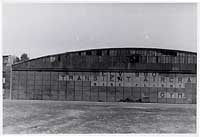
1. Unidentified Constabulary airfield (89 KB)
|
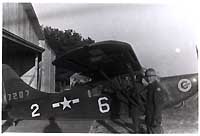
2. L-4 liaison aircraft (79 KB)
|
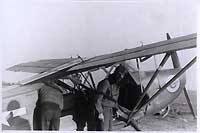
3. Another L-4 used by the Constabulary (80 KB)
|
|
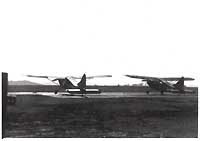
4. Two liaison aircraft of 6th Constab Regt (54 KB)
|
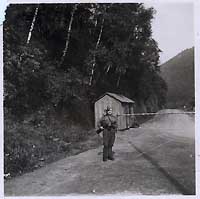
5. Russian border post (93 KB)
|
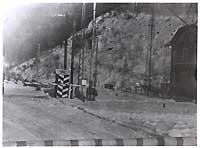
6. Russian border post at Falkenstein (123 KB)
|
|
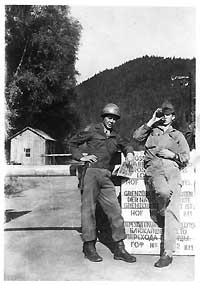
7. Border guard and soldier (116 KB)
|
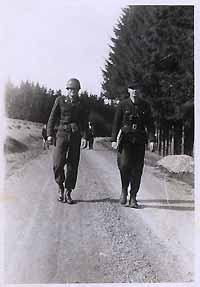
8. Constabulary trooper and German Border Police (124 KB)
|
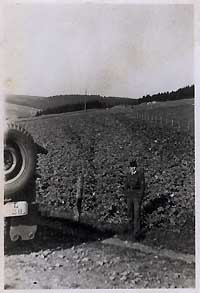
9. German Border Police (130 KB)
|
|
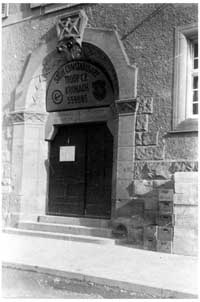
10. Troop Command Post, Kronach (132 KB)
|
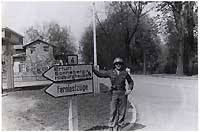
11. Trooper in Coburg with the Ketschentor in the background (122 KB)
|
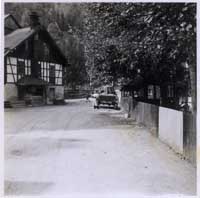
12. M-8 on side of road (93 KB)
|
|
|
|
| |
| 1947 |
|
|
|
|
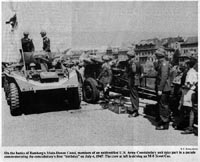
1. 13th Con Sq in Bamberg, July 1947 (KB) |
|
|
|
|
 |
|
| |
| 10th Constabulary Regiment |
| |
| (Source: Email from Dan Langhans, son of Lewis Langhans, Jr. who served with the 72nd Constabulary Squadron) |
|
|
|
|
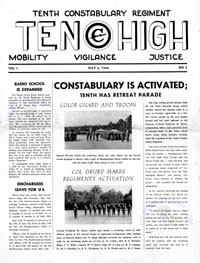
Page 1, May 6, 1946 |
|
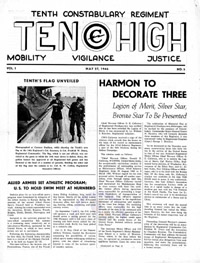
Page 1, May 27, 1946
|
|
|
 |
|
| |
| 72nd Constabulary Squadron |
| |
| (Source: Email from Dan Langhans, son of Lewis Langhans, Jr. who served with the 72nd Constabulary Squadron) |
My father was Lewis Langhans Jr. who joined the 3rd Armored Division in April of 1945. He was with Co. A of the 36th AIR. In the fall of 1945 he was moved to the 1st Armored Division and from what I can make out in some of his notes he was with the 10th Tank and then 10th Reg., 72 Sq. of the US Constabulary.
I have the first Constabulary newpaper and a couple of the 10th Reg. papers. I have been in contract with the 1st Armored Musem in Germany as I am trying to ID some photos of where my father was at a ski school. I am going to attach some photos for you and I have others.
My father's unit (Co. A) still gets together and I am working with them on many history projects. We have collected over 400 photos and have many named. This part after dad left the 3rd Armored is pretty empty for me in terms of history. My father, like many others, did not talk about the war but I am trying to put the places together with the pictures for future generations. |
|
|
|
|
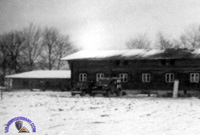
1. Ski Lodge (KB) |
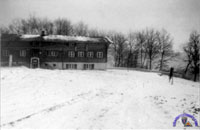
2. Ski Lodge (KB) |
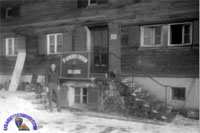
3. Entrance with sign (KB) |
|
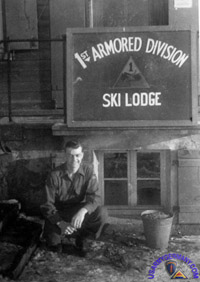
4. Lewis Langhans (KB)
|
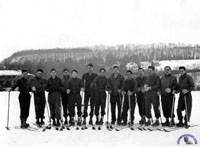
5. Some of the guests at the Ski Lodge (KB)
Click here for article on the 1st Armd Div Ski Lodge at Degenfeld (near Geislingen)
|
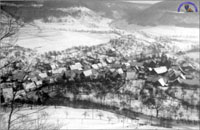
6. Looking down on Degenfeld (KB) |
|
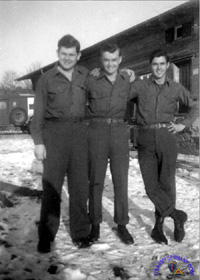
7. (KB) |
|
|
|
|
|
|
|
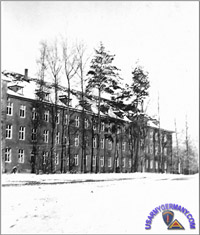
1. Panzer Ksn, Böblingen (KB) |
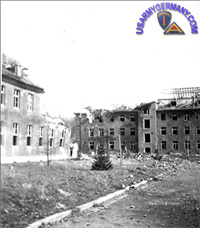
2. War damage to barracks (KB) |
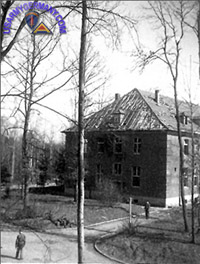
3. (KB) |
|
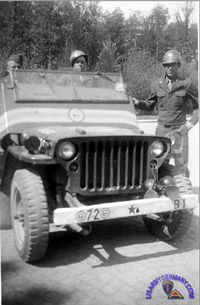
4. B Trp jeep (KB) |
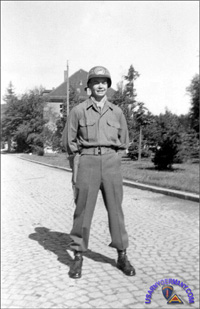
5. Lewis Langhans (KB) |
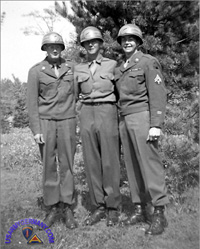
6. Lewis and buddies (KB) |
|
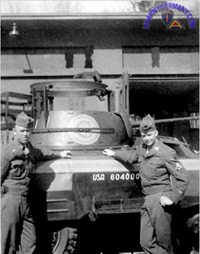
7. Armd car (KB) |
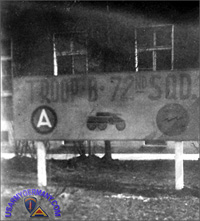
8. Troop B, 72nd Con Sqdn (KB) |
|
|
|
 |
|
| |
| 14th Constabulary Regiment |
| |
| (Source: 14th Armored Cavalry Regiment, 1952 Yearbook) |
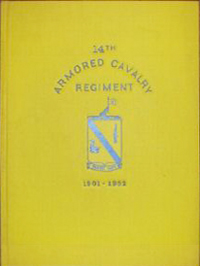
1952 Yearbook
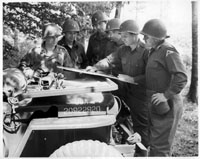
Officers study map
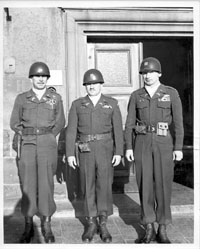
Three officers of 2nd Bn
|
|
In August 1945, the Commanding General, European Theater of Operations was directed to prepare to move Headquarters & Headquarters Troop, 14th Cavalry Group, Mechanized, from Europe to the United States on a permanent change of station. Necessary plans were made and the unit assigned a ship number. Orders were issued indicating that upon arrival in the United Stares, the Group would proceed to Camp Campbell, Kentucky and be assigned to Army Ground Forces and 2d Army. In October 1945, the orders directing the return of the 14th Cavalry Group to the United Stares were rescinded. Records become a little vague for the next few months. It would appear that a token number of personnel remained assigned to headquarters in order to keep it active, since records indicate that 1st Lt. George D. Crosby was commanding in January 1946, and Captain James C. McConnell in February 1946.
In March 1946, die Headquarters & Headquarters Troop, 14th Cavalry Group Mechanized, was redesignated Headquarters & Headquarters Troop, l4th Constabulary Regiment, and was reorganized in accordance with T/O&E 20-212T (20 Mar 46). The unit was relieved from assignment to US Forces European Theater (USFET) and placed under the Theater Commander. Colonel Louis J. Copton assumed command of the newly organized Regiment. The redesignation and reorganization became effective 1 May 1946, at Kitzingen, Germany.
The period following the reorganization was one of many changes. Personnel were returned home on rotation, subordinate units were re-located at various kasernes, areas of responsibility as well as methods of accomplishing the occupation mission were reviewed and changes made where necessary. Border and interior check points were established and the number of mobile patrols were cut down.
June 1947 saw the Regimental Headquarters at Kitzingen, the 10th Squadron at Wurzburg, the 27th Squadron at Schweinfurt and the 22d Squadron at Hammelburg.
On the 20th of September 1947, certain of the Constabulary Regiments were inactivated among which was the 1st Constabulary Regiment. Personnel from the 1st were assigned to the 14th and further assigned in the Regiment's Squadrons.
Following the inactivation of the 1st Constabulary Regiment, the 14th again was re-located and became operational at Fritzlar. The 10th Squadron joined Regimental Headquarters at Fritzlar while the 22d Squadron moved to Hersfeld and the 27th Squadron moved to Darmstadt.
Border posts were turned over to the West German Police and training of the individual and small units became the key note. Numerous practice alerts to quell simulated riots and civil disturbances were held. During this period a plan to seal off a portion of the zonal border was placed in effect from time to time. The purpose of the plan was to intercept contraband articles and to control illegal traffic into and out of each Squadrons zone.
The next important event recorded in the history of the Fourteenth occurred in December 1948. At this time the 14th Constabulary Regiment was redesignated the 14th Armored Cavalry Regiment (U.S. CON) and reorganized according to T/O&E 17-51, 7 October 1948 with an authorized strength of one hundred thirty nine officers, eleven warrant officers and two thousand four hundred and sixty enlisted men.
The 10th Constabulary Squadron became the 1st Battalion, 14th Armored Cavalry Regiment and remained at Fritzlar with Regimental Headquarters and Headquarters Company and Service Company. The 22d Constabulary Squadron was relieved from assignment to the Regiment but became one of the Regiment’s attachments with station at Hersfeld. |
|
At the same time the 27th Constabulary Squadron was inactivated and the 1st Constabulary Squadron moved to Schweinfurt where it was also inactivated and reorganized its 2d Battalion, 14th Armored Cavalry Regiment (US CON).
The 6th Constabulary Squadron was redesignated and reorganized as the 3rd Battalion, 14th Armored Cavalry Regiment (US CON), with station at Coburg, Germany.
Under the command of Colonel Edward J. Maloney, the 14th embarked upon a program of hard and intensive training the purpose of which was to train the Regiment as a combat unit, ready and able to accomplish any mission within the capabilities of its organization and equipment.
The responsibility for internal security of the zone was shifted from the newly organized tactical units to the military posts and the transition from a police force to trained combat unit was underway.
The period from December 1948 to November 1950 saw no change in location of the Regiments subordinate units. The main endeavors of all concerned continued to be training and much was accomplished to bring the organization to a high state of combat readiness. Maximum use was made of available training areas. Companies and battalions spent a great part of their training time away from their kasernes engaged in training at Munsingen, Belsen, Baumholder, Grafenwohr and Wildflecken as well as participating in small and large scale maneuvers and field exercises throughout the zone. The Regiment's progress and training achievements are best noted with the observation that the 14th Armored Cavalry Regiment won every major military competition conducted by Headquarters United States Constabulary during the year 1950. Units representing the best from each Constabulary Regiment participated in proficiency tests involving all phases of military activity. Most significant among the attainments of the Regiment were the first places won by "C" Company in the Rifle Platoon proficiency test, "H” Company in the Reconnaissance Platoon competition and 2d Battalion's Tank Platoon in the medium tank competition.
During the same period the 2d Battalion tied for first place with a battalion from the 2d Regiment in the Battalion proficiency rest. While at the close of the year the Regiment's 3d Battalion was named "the best" Armored Cavalry battalion in the US Constabulary for 1950. The latter competition being judged on a monthly basis with the battalion with the most wins during the year declared champion.
In October 1950, the 3rd Battalion moved from Coburg to Friedberg, Germany. The following month Regimental Headquarters and Headquarters Company, Service Company, Medics and 84th Constabulary Band, joined the 3d Battalion at Friedberg. The close of the year 1950 saw no further changes in location of the 14th and its subordinate units.
In February of 1951, Colonel James B. Quill, Regimental Commander during the period 1950, turned over command of the 14th to Colonel Chandler P. Robbins.
During May 1951, the 2d Battalion moved from Schweinfurt to Bad Kissingen, while the 3d Battalion moved from Friedberg to Hersfeld.
In June, Regimental Headquarters moved on a temporary change of station to Gelnhausen and in August the 1st Battalion moved from Fritzlar to Fulda on permanent change of station.
|
|
| |
| (Source: By William Tevington,
Museum Liaison) |
| THE 14TH CONSTABULARY REGIMENT
The 14th Cavalry Group Mechanized, the preceding unit, had the unique distinction of being commanded for the month of January 1946 by a Lieutenant George D. Crosby and in the month of February 1946 by a Captain James C. McConnell.
As of 20 February 1946 the 14th Cavalry Group came under the control of Headquarters United States Constabulary with Colonel Louis J. Compton,
Commanding. It was reorganized and redesignated as the 14th United States Constabulary Regiment with the following units assigned. 10th Infantry Battalion. 22nd and 27th Armored Artillery Battalions. These units became the 10th, 22nd and 27th Constabulary Squadrons. The Squadrons were initially located at:
10th Squadron Headquarters along with Regimental Headquarters at Kitzingen. The individual troops were located as follows: A Troop at Lohr; B Troop at
Elsenfeld; C Troop at Ochsenfurt, D Troop at Fritzlar and E Troop at Kitzingen.
22nd Squadron was at Hammelburg with the Troops stationed as follows: A Troop at Melrichstadt; B & C Troops at Hammelburg; D Troop at Bad Neustadt and E Troop at Ostheim. The 27th Squadron was at Schweinfurt with A & B Troops at Marolisweisach; C Troop at Schweinfurt; D Troop at Koenigshofen and E Troop at Schweinfurt. When the 1st and 3rd Regiments with their assigned squadron were deactivated many changes occurred in the 14th. Many transfers were made and personnel from the 1st and 3rd filled in empty spaces in the 14th. It was at this time when the first of the many moves the 14th and its units were to make over the next five years before finally settling down. The Regiment and the 10th Squadron found themselves at Fritzlar, the 22nd at Bad Hersfeld and the 27th at Darmstadt. During this period of time all the units pulled their share of "Border Patrol, Check Point and Displaced Camp Duty". At this time the Regiment was Commanded by Colonel Edward J. Malony and had probably one of the finest Executive Officers in Lt. Col. Kurt G. Radtke both were Infantry. But we won't hold that against them.
During the period of transition from Constabulary duty the Regiment was Commanded by Colonel John L. Ryan Jr. the right choice in implementing the
reorganization that was being directed by the new Constabulary Commanding General: Major General I.D. White.
A little personal note about Colonel Ryan -- he took cooks, clerks and some others from Headquarters and during an "Aggressor period" went out and "Captured" the Colors of the 18th Infantry Regiment. During this period the Squadrons were again redesignated and were assigned back to their original units. The 1st Battalion was the old 10th Squadron, the 2nd Battalion was originally the 1st Squadron of the 1st Regiment and the 6th Squadron of the 6th Regiment became the 3rd Battalion. The Regiment and the Battalions moved to Friedberg, Gelnhausen, Fulda, Coburg and Hersfeld. But, really the units were spending time at various training facilities in Germany. The Regiment and its units were augmented by the 373rd Armored Infantry Battalion, the 547th Combat Engineer Battalion and some Ordnance units
Many fine men had Command of the Regiment among them Colonels James B. Quill and Chandler P. Robbins. It goes without saying that many great things were accomplished because great leadership. Those of us that served in any of these Units can be justly proud that we served to instill democracy and fair play in those that we came to protect and serve. There were times that we want to forget but there are many things that we can be proud of . The Berlin Airlift and the "Vittles Bowl Football Game" for the children of Berlin. We can be justly proud of the fact there was never a courts-martial for theft during any operation.
WE WERE THE BEST OF THE ELITE
SUIVEZ MOI |
 |
|
| |
| 27th Constabulary Squadron |
|
|
|
|
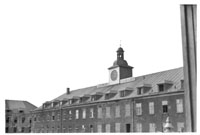 1. 27th Con Sq Hqs building, Ledward Barracks, 1947 (KB) 1. 27th Con Sq Hqs building, Ledward Barracks, 1947 (KB) |
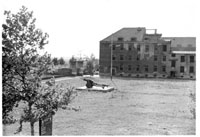 2. Retreat cannon (KB) 2. Retreat cannon (KB) |
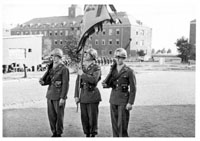 3. 27th Con Sq color guard (KB) 3. 27th Con Sq color guard (KB) |
|
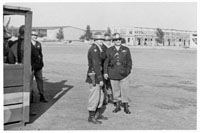 4. Squadron officers (KB) 4. Squadron officers (KB) |
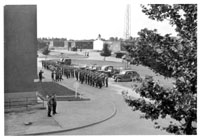 5. Retreat (KB) 5. Retreat (KB) |
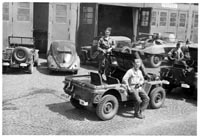 6. Maintenance area (KB) 6. Maintenance area (KB) |
|
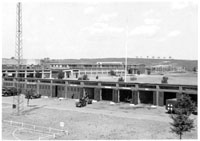 7. Supply shops (KB) 7. Supply shops (KB) |
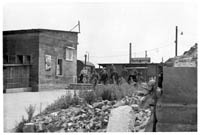 8. Maj Gen Frank Milburn arrives for a visit, July 1947 (KB) 8. Maj Gen Frank Milburn arrives for a visit, July 1947 (KB) |
|
|
|
|
|
| 1947 |
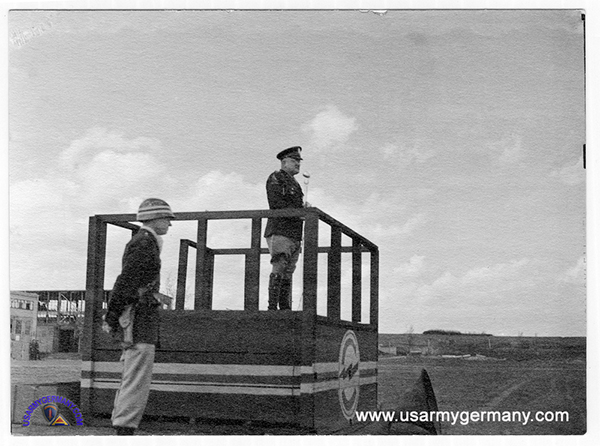
Maj Gen Ernest Harmon at Ledward Barracks, Schweinfurt, April 1947 |
| |
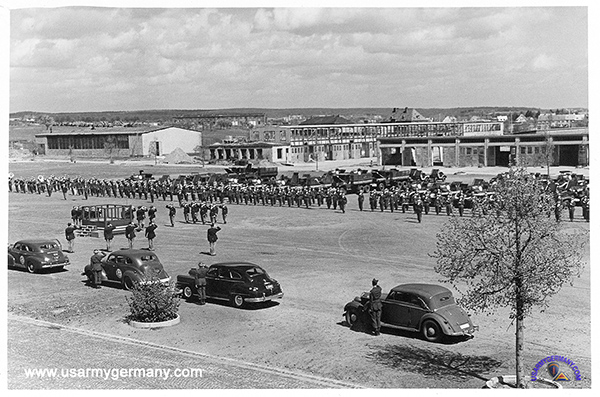
The 27th Constabulary Squadron in formation during a visit by MG Harmon, April 1947
|
| |
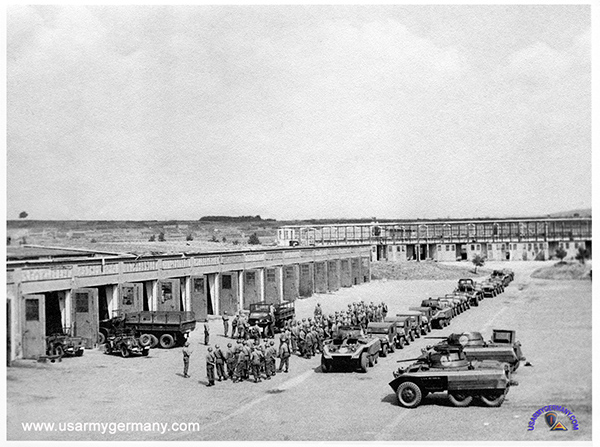
"B" Troop, 27th Contsab Sq prepares for a "show of force" patrol, 1947 |
| |
|
|
|
|
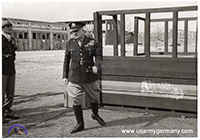
9. MG Ernest Harmon |
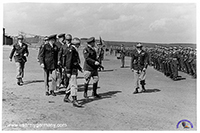
10. Gen Harmon and other Constab officers at Schweinfurt |
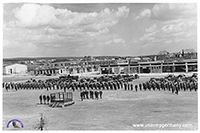
11. 27th Constab Sq review |
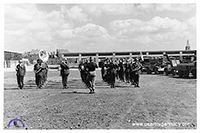
12. Constabulary Band |
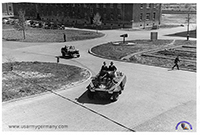
13. Sq Hqs building |
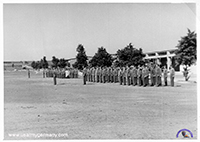
14. Retreat |
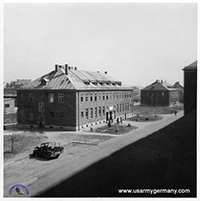
15. Mess hall |
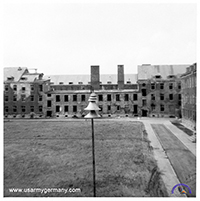
16. Bomb damaged barracks |
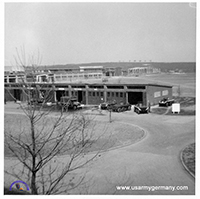
17. Maintenance Shops |
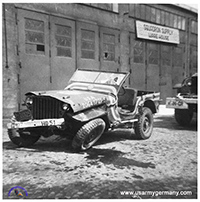
18. 27th Constab jeep after accident |
|
|
|
 |
|
| |
Related Links:
|
| |
|
 200 BLUE BG.jpg)























































